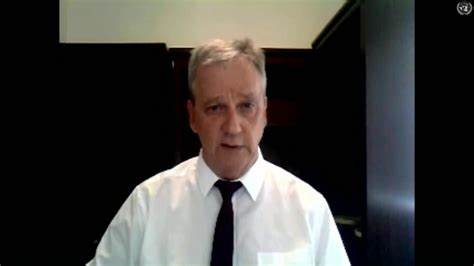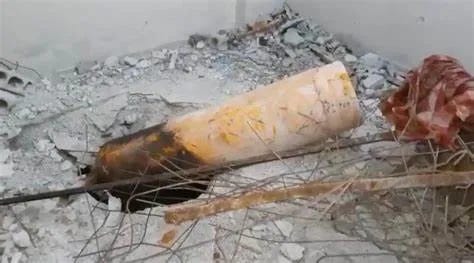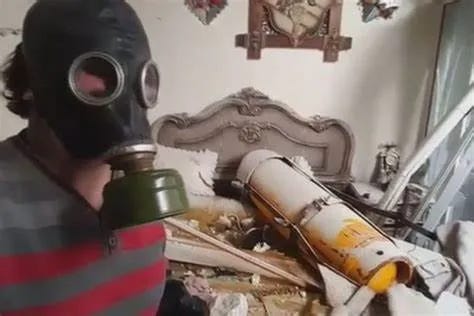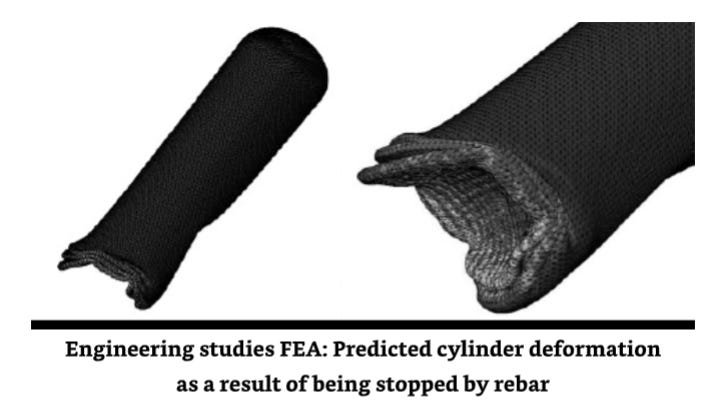Inside The Suppressed OPCW Evidence On Syria The Public Was Not Meant To See.
Newley released details from a whistleblower from within the OPCW delivers a blow to official Western narratives.
In April of 2018, the U.S., UK, and France bombed Syria over what was alleged to be a Chlorine gas attack on civilians in the Syrian suburb of Douma, in Damascus.
This bombing took place before inspectors from the OPCW (Organization for the Prohibition of Chemical Weapons), the UN’s chemical weapons watchdog, were able to go to Douma to find out what actually happened.
The evidence used to justify the bombing were videos and photos of what is estimated to be 43 civilians found dead in an apartment building in Douma, along with two chlorine gas canisters that were found on top of the apartment and on a bed in another building.
After the OPCW had investigated the crime scene in Douma, they put out a report that suggested the attack was a result of chlorine cylinders dropped from Assad regime helicopters.
However, a censored report that the team who originally went to Douma wrote was released to Wikileaks, which came to much different conclusions, suggesting the massacre was a false flag.
Two of the most alarming findings of the report were that the rapid foaming at the mouth of victims was not consistent with Chlorine gas and that the cylinders at the scene were more likely to have been “manually placed at those two locations rather than being delivered by aircraft”.
This finding came from an engineering assessment, written by one of the OPCW’s top inspectors, Ian Henderson, who conducted it with the help of experts from two top universities.
Ian Henderson has recently released a tell-all book titled “The Syria Scam: An Insider Look Into Chemical Weapons, Geopolitics and the Fog of War”.
In a previous article, I wrote about the most important revelations in the book.
However, in this article, I will focus specifically on Ian Henderson’s engineering assessment, the story behind how it was written, and the remaining unanswered questions discussed in the book.
Pictured Above: OPCW inspector Ian Henderson testifying at the UN on the suppression of his engineering study.
The Engineering Assessment in Douma.
For reference, there were photos and videos of two chlorine cylinders in Douma, one in what was referred to as “location 2” and another in what was referred to as “location four”.
Pictured Above: "Location 2” cylinder.
Pictured Above: “Location 4” cylinder
Ian Henderson visited these two locations in Douma, taking photos and measurements, and authored an engineering assessment with the help of two top Universities.
As mentioned above, the assessment found that the two cylinders were likely “manually placed rather than being delivered by aircraft”.
Pictured Above: Conclusions of a rough draft of Henderson’s engineering assessment published to WikiLeaks.
How the study was conducted
In his book, Henderson details that he conducted his study after he contacted “a professor at a university,” which led to “meeting a second professor at another university” who agreed to “do the (ballistics) work”.
The professors originally believed the official narrative about what happened in Douma but later changed their view once the evidence showed otherwise. As Henderson wrote:
Their initial expectation appeared to be that the Syrian regime was responsible for a chemical attack, and I didn’t argue against that. To their credit, they did the work properly and reported the outcome with integrity, despite that outcome being different from what they had initially expected.
Henderson also noted that the study was widely accepted by all OPCW experts, writing:
Nobody in the Douma team expressed disagreement or serious doubts; on the contrary, most were enthusiastic about having had a proper analysis conducted on the cylinders. I remember the feedback I got from one guy on the team. He was quite animated when saying, ‘This is what we’ve been supposed to be doing all along with these FFMs (Fact Finding Missions); why hasn’t anyone done this before?’
Furthermore, in the book, Ian Henderson lays out several findings in his study that no one has been able to counter.
Location 2
The OPCWs fraudulent “response” to Ian Henderson’s Study.
The OPCW leadership, which has never met with or been willing to listen to Ian Henderson, did make one attempt at countering his study.
In a report released in 2023, the OPCW’s IIT ( Investigation and Identification Team) attempted to refute Henderson’s study.
For context, the IIT is a subdivision of the OPCW created to ascribe blame for which party is responsible for the chemical attacks.
A group of current and former OPCW officials have put out an open letter stating that “a number of impartial and principled professionals no longer wish to be associated with the politically motivated reports being issued by the OPCW FFM and now the IIT.”
The political bias at the IIT is evident from their attempt to counter Henderson’s study.
The IIT report argued that Hendersons' report argues the cylinders were placed because “In the simulations considered in the ‘Engineering Assessment’, the cylinder penetrates the concrete on the rooftop at Location 2”, whereas in the pictures and videos the cylinder does not.
The IIT report argues that this study is flawed because it only tested for “a minimum drop altitude of 500 m”.
The IIT report claims that “the results presented in the ‘Engineering Assessment’ should, at best, have led its author to conclude that the cylinder, if air dropped, would have been so from a height of less than 500 m.”
The IIT report argued that the cylinder was indeed dropped from “a low-flying helicopter from heights of at least 140 m”.
This is a fraudulent response for two major reasons.
First, it is extremely unlikely that a Syrian helicopter would be flying lower than 500 meters.
Henderson noted that originally “an inspector with experience on FFM investigations, pointed out that in previous allegations (of chemical attacks) it had generally been reported that the helicopters had been flying quite high, at altitudes high enough to be out of range of ground fire, perhaps 5,000 to 10,000 feet or higher.”
Because of this, he originally “settled on 2,000 metres as the base case and 5,000 metres for the limiting highest case” for the study but later decided to “add a lower height of 500 metres” due to the “modest deformation on the cylinder”.
Henderson noted that it is extremely unlikely for there to be a low flying helicopter over Douma, writing:
The case of a low-flying helicopter like this had not been reported previously and, as any military type will tell you, would be unlikely. For a helicopter of the type assumed to be dropping barrel bombs or alleged chemical weapons from that low altitude, we must assume there wouldn’t be simultaneous artillery bombardment or airstrikes in the area. Therefore, we have a noisy, slow-moving, unprotected helicopter flying low above enemy-occupied urban territory – an invitation for disaster. That height would bring the aircraft into range of ground fire by anti-aircraft weapons, heavy machine guns, RPGs148 and even the ubiquitous AK-47, leading to a perilous situation for the helicopter crew.
However, it is possible that, for some reason, a Syrian helicopter was flying that low.
However, what is not explainable- and what the OPCW IIT report glossed over is the inconsistency between the cylinder at “location 2” and the crater it allegedly made.
The Contrary Smoking Gun
The fact that the cylinder dropped from 500 meters or higher- would have crashed through the roof, was only a small part of Henderson’s study.
The crux of it was that the damage to the roof was not consistent with the damage done to the cylinder.
Henderson writes that he is “confident in the credibility of the institutions” he used for the study and explained that he used FEA (Finite Element Analysis) to determine this.
Henderson cited an example of the accuracy in this method’s prediction depending on “how good the input data is and how effective the methodology is”.
Pictured Above: FEA prediction of damage to a metal tube compared to real impact.
Henderson was able to get specific details on the chemical cylinder and, therefore, could predict its deformation. As he wrote:
Since there were manufacturer’s stamps on it, we were able to establish the design, dimensions, metallurgy and mechanical properties of the cylinder. This would allow us to predict, for a range of impact scenarios, the plastic deformation that would occur. In other words, how squashed-up it would be.
When Henderson and his team conducted this study, they found that the damage to the cylinder at “location 2” was not consistent with the damage to the metal rebar in the crater it allegedly caused.
Pictured Above: What the Cylinder nose looked like at “Location 2”
Pictured Above: What the Cylinder nose should have looked like at location 2.
Then, there is also the question of what caused the crater. A picture was taken by the OPCW team of the underside of the crater at location 2.
Pictured Above: Picture Taken of Crater from underside of Location 2
Henderson noted that:
No FEA simulations, either from the FFM report or engineering studies, replicated the characteristics of the observed crater underside. Engineers and ballistics experts I consulted (the latter from both within the Secretariat and outside) were unanimous in identifying the crater as more likely having been formed by an explosive mechanism, thought to be probably a mortar bomb, artillery shell or rocket artillery round.
Henderson noted that even in the “officially approved” OPCW report on Douma, there is a strange section that states the team saw a “A Crater Similar To The One On The Roof Terrace At Location 2” at an “Adjacent Roof”.
However, despite this, the FFM report claims that it is “unlikely” that the crater at location 2 was caused by an explosive devise because there is an “absence of primary and secondary fragmentation characteristic of an explosion that may have created the crater and the damage surrounding it.”
But as Henderson noted, not only were there “clear signs of fragmentation on the walls of the terrace, as seen in photographs, including those taken by the FFM team” but the OPCW “took a sample of concrete dust from the crater edge, and analysis of this showed the presence of 2,4,6-trinitrotoluene (residues of the explosive TNT)”.
Pictured Above: TNT sample found in “concrete debris from the crater edge in front of the cylinder nose.
This all strongly suggests that the crater in location 2 was already created by a mortar shell, to have the chlorine gas canister placed inside it afterwards.
No matter what caused the crater, though, the real “contrary smoking gun,” as Henderson calls it, is “the smooth unsullied nose of the Location 2 cylinder”.
Henderson noted that because he had the “dimensions, metallurgy, design codes, specifications and mechanical properties” of the chlorine cylinder, he was able to conduct a “credible FEA study to see what would happen to the cylinder”.
As shown above, Henderson and his team found that “the Location 2 cylinder in particular does not look as it should have, assuming it had made the crater, regardless of theoretical drop height.”
This bombshell finding from Henderson has yet to be addressed by the OPCW.
As many have argued since 2019, the solution to all of this is to have the OPCW meet with Ian Henderson, along with his fellow dissenting inspector, Brendan Wheelan, to have their concerns addressed.
Given the amount of deceptions the OPCW leadership has put out to try to discredit the whistleblowers, it seems unlikely they will ever get a fair hearing, but possibly, this new evidence from Henderson will give them a chance.
Note to readers: The Dissident is a reader-supported outlet. If you liked this article, consider becoming a paid subscriber.














All this information was available to activists and shared widely at the time. The fact that this requires repeating now shows how much the main stream media has ignored the evidence and obeyed directives from the International Crime Syndicate to cover up truth.
Arron Matte exposed this 2 years ago